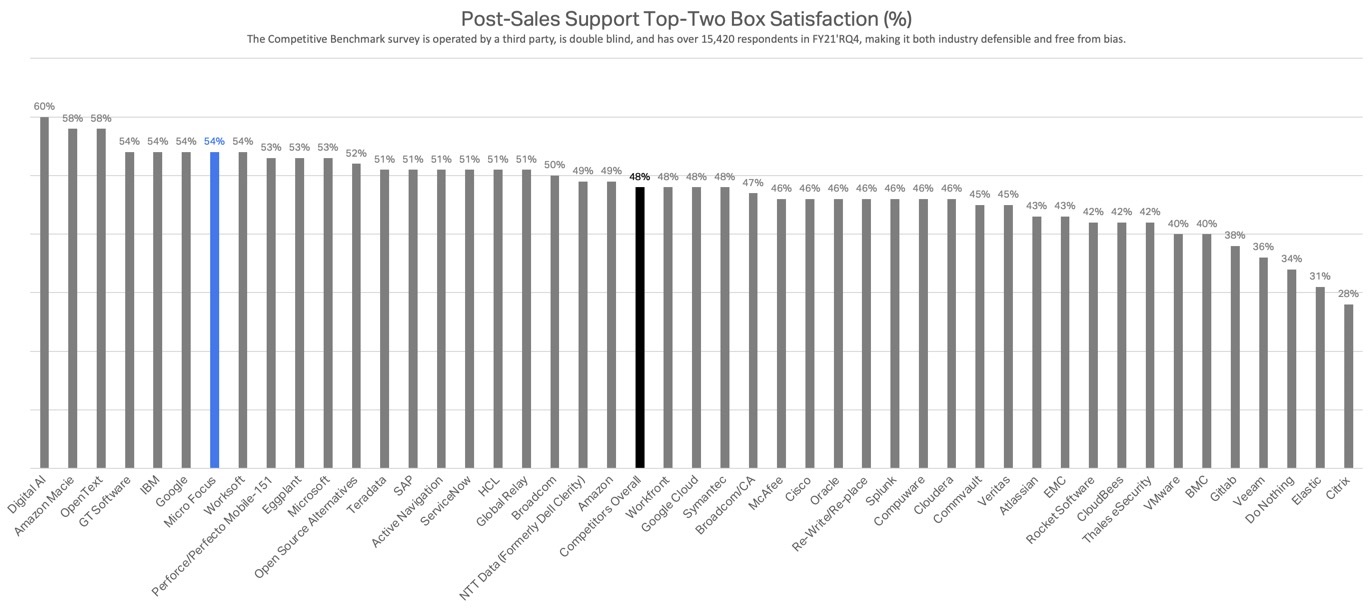Micro Focus Post-Sales: Supported
I am Dr. James D. Borderick, and I look after the Competitive Benchmark research for Micro Focus, which I have been doing for over five years. I wish to share some very interesting statistics with our followers regarding satisfaction with Post-Sales Support.
How do we measure Post-Sales Support?
Micro Focus uses double-blind competitive benchmarking to gauge how well we are doing against the competition. This strategy means we can understand how we are performing with a high degree of statistical accuracy using a highly repeatable and scientific method. There are a number of customer lifecycle touchpoints and brand image attributes that are tracked, and Post-Sales Support is one of them.
What is Post-Sales Support?
Post-Sales Support has an industry definition of “Your experience across all forms of product/service support after the purchase” and helps to ensure that customers gain as much use and value as possible out of their purchase. The business reasoning behind Post-Sales Support is that it can contribute to brand loyalty and repeat sales; happier customers tend to create repeat customers. Good Post-Sales services can result in positive word-of-mouth for a company. Poor Post-Sales support can prevent companies from achieving a good customer satisfaction record and therefore growth.
What is the Relative Impact of Post-Sales Support on Net Promoter®?
Micro Focus, via Competitive Benchmarking, also know that the Post-Sales Support touchpoint provides 6.7% of the relative impact on Net Promoter®, or the relationship metric. This is important to realise since all touchpoints contribute in some way to the overall ‘relationship’ metric with a company, and thus, using the right metric at the right time is not only important, but necessary (but that’s a topic for another time).
So how are Micro Focus performing against the competition in Post-Sales Support?


The figure above presents the Post-Sales Support top-two box satisfaction for each brand* at the worldwide level in software. This percentage shows the number of customers responding with the top scores. A way of interpreting this is if there is a value of 48%, then 1 in 2 of customers liked the Post-Sales Support and 1 in 2 didn’t like it. Generally, then all software companies are not that great at Post-Sales Support (average is 50% top-two box satisfaction) and so for Micro Focus to be seventh in the industry is a great feat indeed. Micro Focus Post-Sales Support is 6% better than the average competitor in the industry and is 7th out of all competitors with a top-two box satisfaction of 54%. When we compare against some of our competitors, we see that we are 1% better than Microsoft, 3% better than ServiceNow, 8% better than Splunk and 14% better than BMC.
*Sample Size Worldwide: n=15,420, Micro Focus n=1,085, and all competitors n=14,335. Data is from November 2020 to October 2021.
Why is the Competitive Benchmark industry defensible?
We do not know who the respondents are, and they themselves do not know that Micro Focus is sponsoring the study, thus this study has a dramatically lower bias than other surveys. We can safely say that the data analytics is performed at the 90% Confidence Level, which is unheard of in the industry. This means if any of our competitors performed the same study, they would have the same results. Couple these points with a data sample size of over 15,000 respondents per rolling quarter and we have a Benchmark that truly is industry defensible.
Don’t hesitate to contact me on Twitter to talk directly if you’d like, especially if you have suggestions for how the teams at Micro Focus could improve their Post-Sales Support satisfaction further!
This post was first first published on Home | Micro Focus Blog website by DrBorderick. You can view it by clicking here

